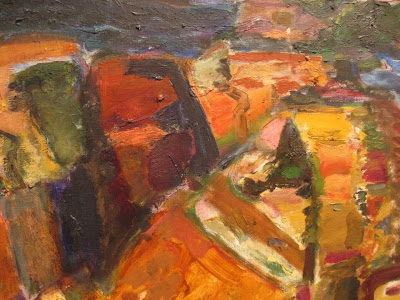INTERVIEW: An Abridged Conversation with Swarthmore College List Gallery Director Andrea Packard
(Author's note: This abridged interview with List Gallery director Andrea Packard was conducted in early September 2012 and concerns the Bernard Chaet show which ran at the gallery from September-October 2012. The review I wrote of the show can be found here. Enjoy!)
I On the Arts: What
led to the selection of the artist? Of his works?
Andrea Packard: This show was
selected, like many of our shows, [from] a conversation between me and the
studio art faculty of Swarthmore. So we
see each other constantly and exchange ideas, but we have formal meetings at
least once a year to talk about the future, and we try specifically to choose
exhibitions in a variety of media that inform our studio arts curriculum. Then, in addition to that, we look for shows
that might provide bridges to other disciplines, or appeal to broader audiences,
and so we were discussing sculptors, video artists, you name it… Logan Grider,
who teaches here, suggested Bernard Chaet.
And so we all looked at his work online… and thought, of course, “of
course; we should do this”… It was left to me to explore the feasibility of
this idea. I talked to the galleries
that represent the artist and I talked to the family of the artist and figured
out how this show could come together… I went there over the summer and
selected about 19 works… this work comes from three sources: two galleries and
the artist’s own collection.
IOtA: How far in advance
do you plan the exhibits?
AP: At least a year in
advance. Some shows have been planned
two or three years in advance. I already
have a plan for a show in the spring of 2014 to coincide with our sesquicentennial
at the college…
…A
lot of this work is recent; I think some of it’s as new as 2008 or 2009… Here’s
an artist who has sixty years making paintings and he taught for at least
thirty years… We’re just sort of celebrating a really varied and accomplished
life in art by bringing this show here.
It’s by no means comprehensive because he has a much broader output and
we really decided to narrow our focus just to his seascapes. But his landscape paintings and his seascapes,
I think, are the heart of his art; it’s really, perhaps, arguably the core of
his practice… I hope this show represents something of the essence of his
spirit of inquiry.
IOtA: So how many years
are spanned in this exhibit?
AP: …Of the works I brought here, I hung nineteen
works out of about thirty works that I borrowed… The works that I brought here span from 1977
to 2009.
IOtA: So…why the sea?
AP: I can’t speak for him, obviously, but so many
artists throughout history have engaged with the sea as a topic. It’s universally mesmerizing…
IOtA: Like Edward Hopper and Winslow Homer.
AP: Yeah, although I
would say his antecedents are… [different]… when he was coming of age, at that
time in Boston a lot of artists were the expressionists [such as] Max Beckmann… he studied with artists who connected
him with the European expressionists…. When you look at his paintings,
immediately you think of a lot of great expressive interpreters of the
landscape… Chaet’s about the elasticity of the brushstrokes and the drawn line,
and if you look at the pictures, a lot of times you just look at the lines and
how they do from wispy and thin to meaty and thick. There’s a tremendous range and musicality.
IOtA: It’s interesting because you mentioned that
he was inspired by the many expressionists, but I did some research on his
works and I thought Cezanne, Gauguin, that Post-Impressionist style…
AP: Absolutely.
IOtA: And a little bit of Fauve… maybe a touch.
AP: Yeah, maybe a touch.
IOtA: Because of the brightness of the colors.
AP: There are some works that are not in this
show that are quite intense! It’s just
that when you hang a show…what paintings you put next to each other can really
make them cancel each other out…and make them lose their uniqueness… Even
though they’re all seascapes, there’s a tremendous variety… hopefully we’ve
captured something of that…. It’s not that each work derives from [an artist
inspiration] but that each artwork is an opportunity to think about certain
problems…paintings is a little bit more like poetry than a novel in that sense,
that you take a particular focus and you’re not trying to be epic.

Always interesting to read about how shows are set up and what gallery curators think about the works they select!
ReplyDelete